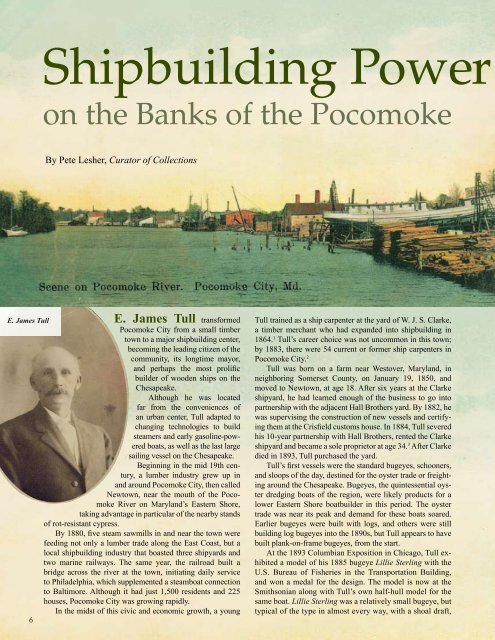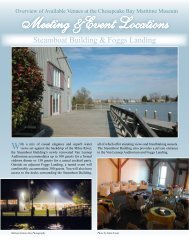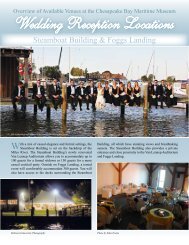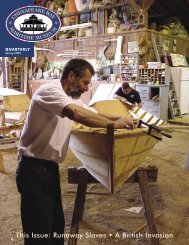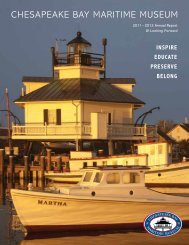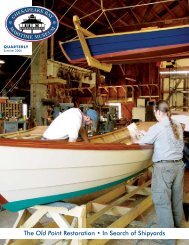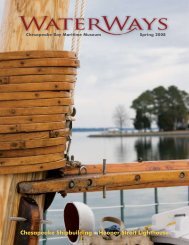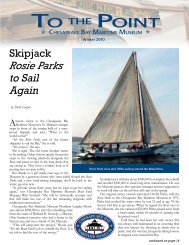Pocomoke Shipbuilding • Vane Brothers - Chesapeake Bay ...
Pocomoke Shipbuilding • Vane Brothers - Chesapeake Bay ...
Pocomoke Shipbuilding • Vane Brothers - Chesapeake Bay ...
You also want an ePaper? Increase the reach of your titles
YUMPU automatically turns print PDFs into web optimized ePapers that Google loves.
E. James Tull<br />
6<br />
<strong>Shipbuilding</strong> Power<br />
on the Banks of the <strong>Pocomoke</strong><br />
By Pete Lesher, Curator of Collections<br />
E. James Tull transformed<br />
<strong>Pocomoke</strong> City from a small timber<br />
town to a major shipbuilding center,<br />
becoming the leading citizen of the<br />
community, its longtime mayor,<br />
and perhaps the most prolific<br />
builder of wooden ships on the<br />
<strong>Chesapeake</strong>.<br />
Although he was located<br />
far from the conveniences of<br />
an urban center, Tull adapted to<br />
changing technologies to build<br />
steamers and early gasoline-powered<br />
boats, as well as the last large<br />
sailing vessel on the <strong>Chesapeake</strong>.<br />
Beginning in the mid 19th century,<br />
a lumber industry grew up in<br />
and around <strong>Pocomoke</strong> City, then called<br />
Newtown, near the mouth of the <strong>Pocomoke</strong><br />
River on Maryland’s Eastern Shore,<br />
taking advantage in particular of the nearby stands<br />
of rot-resistant cypress.<br />
By 1880, five steam sawmills in and near the town were<br />
feeding not only a lumber trade along the East Coast, but a<br />
local shipbuilding industry that boasted three shipyards and<br />
two marine railways. The same year, the railroad built a<br />
bridge across the river at the town, initiating daily service<br />
to Philadelphia, which supplemented a steamboat connection<br />
to Baltimore. Although it had just 1,500 residents and 225<br />
houses, <strong>Pocomoke</strong> City was growing rapidly.<br />
In the midst of this civic and economic growth, a young<br />
Tull trained as a ship carpenter at the yard of W. J. S. Clarke,<br />
a timber merchant who had expanded into shipbuilding in<br />
1864. 1 Tull’s career choice was not uncommon in this town;<br />
by 1883, there were 54 current or former ship carpenters in<br />
<strong>Pocomoke</strong> City. 2<br />
Tull was born on a farm near Westover, Maryland, in<br />
neighboring Somerset County, on January 19, 1850, and<br />
moved to Newtown, at age 18. After six years at the Clarke<br />
shipyard, he had learned enough of the business to go into<br />
partnership with the adjacent Hall <strong>Brothers</strong> yard. By 1882, he<br />
was supervising the construction of new vessels and certifying<br />
them at the Crisfield customs house. In 1884, Tull severed<br />
his 10-year partnership with Hall <strong>Brothers</strong>, rented the Clarke<br />
shipyard and became a sole proprietor at age 34. 3 After Clarke<br />
died in 1893, Tull purchased the yard.<br />
Tull’s first vessels were the standard bugeyes, schooners,<br />
and sloops of the day, destined for the oyster trade or freighting<br />
around the <strong>Chesapeake</strong>. Bugeyes, the quintessential oyster<br />
dredging boats of the region, were likely products for a<br />
lower Eastern Shore boatbuilder in this period. The oyster<br />
trade was near its peak and demand for these boats soared.<br />
Earlier bugeyes were built with logs, and others were still<br />
building log bugeyes into the 1890s, but Tull appears to have<br />
built plank-on-frame bugeyes, from the start.<br />
At the 1893 Columbian Exposition in Chicago, Tull exhibited<br />
a model of his 1885 bugeye Lillie Sterling with the<br />
U.S. Bureau of Fisheries in the Transportation Building,<br />
and won a medal for the design. The model is now at the<br />
Smithsonian along with Tull’s own half-hull model for the<br />
same boat. Lillie Sterling was a relatively small bugeye, but<br />
typical of the type in almost every way, with a shoal draft,


